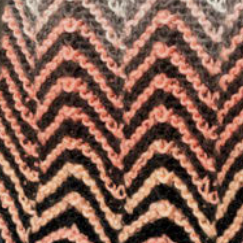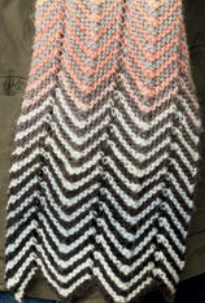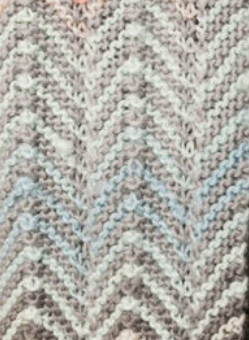I have found two different ways how to do wave stitch in knitting, so now I am confused as to which is the original wave stitch. Perhaps both are correct as they are quite similar.
The wave stitch in knitting is very interesting looking and it is surprisingly easy to knit.
If you look at this pattern you will see that I knitted an entire sweater using this stitch.
Now since then, I have discovered another type of wave stitch in knitting. It looks like this.

Increases and decreases give a gentle wave design to a garment. Even making a scarf using two different multi-colored yarns and alternating the skeins creates a beautiful gradient piece you’ll love.
Here is how you can knit the pattern into a scarf.
Do not break yarn when changing colors; simply carry it up the side.
Here is how you can knit the pattern above into a scarf.
If you need to decipher the abbreviations, you will find them here.
Waves Stitch Pattern
*Row 1 (RS): K2tog, (K5, M1R, K1, M1L, K5, CDD) two times, K5, M1R, K1, M1L, K5, SSK.
Row 2: K across.*
You can try 4.5mm knitting needles and ChromaTM (worsted weight, 70% Superwash Wool, 30% Nylon, 198 yards/100g) or similar type wool.
How To Make A Scarf Using the Wave Stitch In Knitting
With a color of your choice, cast on 43 sts. Knit one row.
Switch to another color, work Rows 1–2 of Waves Stitch Pattern. Switch to first color, and work Rows 1–2 of Waves Stitch Pattern. * – *
Cont working as established, switching between C1 and C2 after every pattern rep, carrying unused color up side of work.
Work in the pattern until the piece measures the desired length of the scarf when measured along the edge, ending after a C2 rep.
BO all sts with C1.
Finishing
Weave in ends, wash, and block.


What a fascinating journey into the world of wave stitch knitting! Michel, your detailed explanation and clear instructions make it so inviting to dive into this pattern. The versatility of this stitch, showcased through both the sweater and scarf, is truly captivating. Your encouragement to experiment with different yarns and colors ignites creativity. I can’t wait to give this pattern a try and create my own gradient piece. Thank you for sharing your expertise and inspiring us to explore new techniques in knitting!
I love knitting, but I don’t get a chance to do it often these days as all my time is taken up getting my Internet Businesses off the ground. But I used to know Aran sweaters and loved the challenge of intricate patterns and stitches. I remember this wave stitch well, but I’ve never seen the second version you display. Lovely.
Btw, can you explain the phrase: ‘Weave in ends, wash, and block.’ I’m not sure what ‘blocking ‘ is as I’m from the UK, and I believe you might be in Japan or the US!
Hi Linden,
I am in South Africa. Weaving in the ends means you take all the loose ends of wool and sew them into the back of the knitted piece to hide them away.
You can read all about blocking by clicking here.
Hope this helps.
Wow, whenever I see a post on knitting it reminds of my childhood! My mother is a very skilled knitter and she used to try and show me how to do it. I was terrible at it, but when I read your post, it seemed that it’s easy like 123 when it’s not. But I might probably try again now. I need some self-confidence and willingness to make mistakes at the beginning!
You will probably do better if. you try again now on your own without the added pressure of your expert Mom looking over your shoulder.